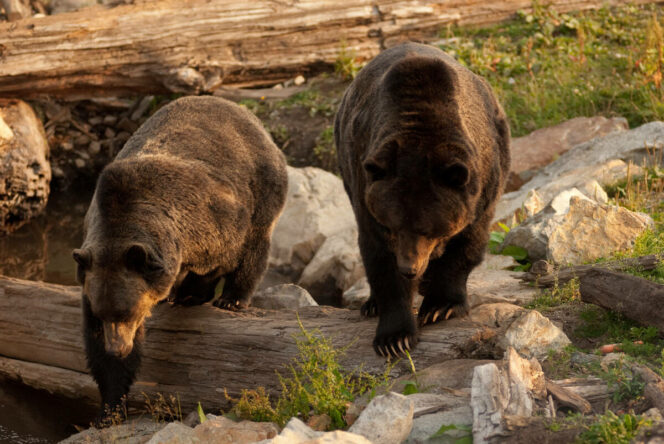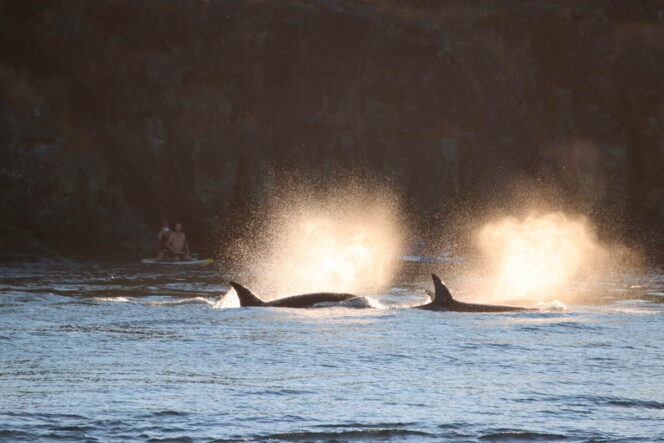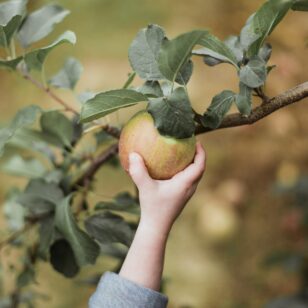
A bear family in Whistler. Photo: Tourism Whistler/Michael Allen
From the forests of Stanley Park to the wilds of the North Shore mountains, you can spot lots of wildlife near Vancouver. Some animals are tiny and cute, while others like bears are bigger and require more caution, but they all deserve our respect. Here are our tips for safely watching wild animals plus places to watch wildlife safely and learn more about them.
Respect All Wildlife
Dozens of species of animals live near Vancouver, including bears, deer, coyotes, raccoons, squirrels, cougars, weasels, beavers, seals, whales, birds, insects, and lots more. Whether you are in an urban park or out in the wilderness, remember that when we spend time in nature, we are visiting an animal’s home.
It’s important to respect wildlife and give them lots of space to access their natural food sources, care for their young, and stay safe from predators. The best way to watch wildlife is from a distance, using binoculars or a zoom lens for a closer look. If the animal changes its behaviour when you get closer, you are too close.
While it might be tempting, never feed wildlife. Human food is junk food for wild animals and it can make them really sick. It also makes them more likely to associate humans with food and they can become aggressive towards people. It can be cute when squirrels or birds bother people looking for food, but it’s not cute when bears or coyotes do it! Don’t give in: respect wildlife by letting them eat their natural food.

Raccoons on a path near Lost Lagoon in Stanley Park. Photo: Pete Nuij/Unsplash
Be Bear Aware
If you’re hiking and spending time in nature near Vancouver, you are in bear country. While bears can seem scary, attacks are very rare and most bears just want to get on with their day. They aren’t interested in humans. However, bears can act defensively if they are startled, eating, or protecting cubs.
Hike in a group and talk or sing to warn bears that you are nearby. Off-leash dogs are one of the main causes of human-bear conflicts, so keep your dog on a leash. Carry bear spray and know how to use it. If you see a bear, don’t run. If possible, leave the area quietly by backing away and avoiding eye contact. If the bear charges or is aggressive, use your bear spray when the bear is close enough. If you are attacked, fight back. BC Parks has lots more tips on staying safe around bears.

Photo: Tourism Whistler/Mike Crane
Learn More About Wildlife
There are lots of places to learn more about Vancouver’s wildlife. Stop in to the Stanley Park Nature House at Lost Lagoon in Stanley Park. You can look at the interactive displays that include real specimens of park wildlife that you can touch. Volunteers and staff from the Stanley Park Ecology Centre can also answer your questions. They also run frequent workshops and events.
In North Vancouver, head to the Lynn Canyon Ecology Centre at Lynn Canyon Park. Their animal gallery has exhibits about black bears, aquatic species, and lots of other local wildlife.
If you want to learn more about bears and other mountain animals, attend a Ranger Talk at Grouse Mountain. A wildlife expert will teach you about Grinder and Coola, the mountain’s resident grizzly bears who were orphaned as cubs. The talks also include info about other mountain species including owls and hummingbirds. Talks are included with your Mountain Admission Ticket.

Grinder and Coola, the resident grizzly bears. Photo: Destination Vancouver/Coast Mountain Photography
Watch Wildlife Safely
One of the easiest and safest ways to watch wildlife near Vancouver is to find a birding spot on the BC Bird Trail. You can spot birds in Vancouver along the Stanley Park Seawall or wading in the shallows in Lost Lagoon, or at Queen Elizabeth Park. There are also BC Bird Trails in the Fraser Valley, Sea to Sky, South Fraser, and Vancouver’s North Shore. Each bird trail has tips on which species you can see at different times of year. To maximize your chances of sightings, try going early and late in the day when birds are most active. Stay quiet and still to avoid startling the birds. And bring a birding guidebook or app to help you identify what you see.
If you want to see wild bears in their natural habitat, you can book a bear-viewing tour in Whistler. You’ll ride in a 4×4 vehicle as your guide takes you to bear viewing areas on Whistler or Blackcomb Mountains or in the nearby Whistler Olympic Park. The local guides know many of the individual bears and can tell you great stories about each one’s personality and quirks.
You can spot lots of marine animals on a whale-watching tour. While orcas and humpback whales are the stars of the show, you’ll also get to see lots of other animals. Curious seals and sea lions are easy to spot lounging on rocks. Bald eagles often dive overhead. And there are always lots of seabirds around. On-board guides will help you identify different species and share fun facts about this unique ecosystem.

















